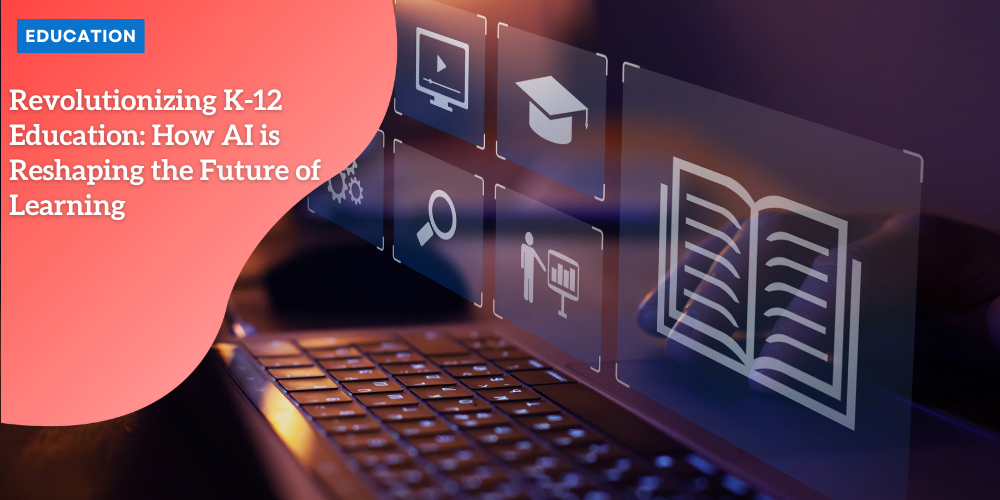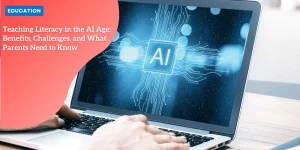Revolutionizing K-12 Education: How AI is Reshaping the Future of Learning

Introduction: The Current Challenges in K-12 Education
The Strain of Traditional Education Methods
The K-12 education landscape has long struggled with bridging the gap between diverse student needs and traditional teaching methods
Anúncios
. A singular approach has often left both struggling students and high achievers without the necessary resources to thrive.
Without personalization, students with unique learning paces or styles fall through the cracks, either unable to keep up or not being adequately challenged.
An Increasing Digital Attention Deficit
The digital age has reshaped how students interact with content, yet this evolution is not reflected in standard classroom settings.
Anúncios
Attention spans are waning, with students’ focus drifting within a matter of minutes.
Despite this, lessons remain lengthy and monotonous, failing to compete with the dynamic media students engage with outside school.
Schools must use more interactive strategies to maintain engagement and capture interest.
Anúncios
Standardized Assessments: A Limited View
Standardized tests have long been heralded as the pinnacle of academic assessment.
However, they often overlook critical higher-order thinking skills like analysis and creative problem-solving.
These assessments measure rote memorization instead, leaving a gap in identifying students’ real capabilities and potential.
The pressure of these high-stakes evaluations can also cause anxiety, which may impair performance and skew results.
As these challenges highlight the need for a shift in educational strategies, we pave the way for a deeper exploration of solutions that leverage technology to meet these complex needs.
The Promise of AI in Education: An Overview
The Growing AI in Education Market
Artificial Intelligence (AI) is emerging as a transformative force in education.
The global AI in education market, valued at $0.8 billion in 2019, is projected to reach $3.7 billion by 2025.
This significant growth is driven by the demand for innovative solutions to enhance learning experiences, making personalized and adaptive education more accessible.
Personalized Learning Journeys
AI transforms learning from a one-size-fits-all approach into personalized journeys by analyzing student performance data.
This technology adapts instructional materials according to individual needs, creating tailored experiences that address both strengths and weaknesses.
Students receiving AI-powered personalized instruction have shown promising results.
Adaptive Learning Experiences
Adaptive learning experiences powered by AI cater to diverse learning styles and paces.
AI tools provide personalized recommendations, supplemental resources, and targeted interventions, enhancing understanding, retention, and engagement.
Empowering Educators
Contrary to fears of AI replacing teachers, these technologies empower educators by automating repetitive tasks and providing data-driven insights.
AI handles grading and personalized instruction, freeing teachers to focus on complex teaching aspects like curriculum development and individualized support.
By better understanding each student’s needs and progress, teachers can craft more effective educational strategies.
AI’s integration into education promises to revolutionize how students learn and how teachers teach.
Personalized Learning: Tailoring Education to Individual Needs
Personalized learning is a game-changer in K-12 education, where the traditional one-size-fits-all approach often leaves many students either struggling or underwhelmed.
AI is at the forefront of this transformation by tailoring educational experiences to individual student needs through detailed performance analysis.
By examining how students perform across different metrics, AI can adapt instructional materials in real-time.
This means that students can receive content tailored to their current understanding, catering to their unique learning styles and paces.
AI also generates personalized recommendations by tapping into students’ interests and weaknesses.
This customization helps in maintaining student engagement and significantly boosts understanding and retention.
For struggling readers, targeted AI interventions can be pivotal. For instance, 65% of fourth graders read below the basic level, but personalized AI tools can offer structured and effective interventions.
Beyond mere adaptation, AI-powered systems foster curiosity by linking learning material with intriguing, context-driven insights that resonate with students’ natural interests.
This dynamic shift not only empowers students but also liberates educators.
Freed from routine customization tasks, teachers can focus on what they do best—engaging and inspiring students. With AI facilitating a more tailored learning journey, the foundations are laid for a deeper conversation on the role of AI-powered applications within classrooms.
AI-Powered Applications Transforming Classrooms
Artificial Intelligence (AI) is making classrooms more dynamic and engaging through various applications that tailor learning to individual students’ needs.
Intelligent Tutoring Systems (ITSs)
Intelligent Tutoring Systems (ITSs) play a critical role in providing personalized and targeted instruction.
By identifying student strengths and weaknesses, ITSs can adapt the difficulty of questions and offer hints or explanations when needed.
This tailored approach not only addresses misconceptions but also helps students achieve a better understanding and mastery of concepts.
Furthermore, the 24/7 availability of ITSs ensures continuous learning support.
Studies have shown that students who use ITSs tend to perform better in assessments due to the focused and personalized practice.
Intelligent Digital Assistants
AI-powered digital assistants, like Siri and Alexa, are valuable tools for students, enabling them to independently explore subjects and seek information.
Utilizing Natural Language Processing (NLP), these assistants can answer questions, provide definitions, and access educational content.
Educational Games and Simulations
Educational games and simulations powered by AI create immersive and engaging learning environments.
These tools simulate real-world scenarios, allowing for virtual experiments and collaborative problem-solving.
Gamification not only boosts motivation and knowledge retention but also cultivates critical thinking skills.
By making learning more fun and interactive, these applications help keep students engaged and interested in the material.
Intelligent Textbooks
Intelligent textbooks utilize AI to provide customized content and interactive features.
These textbooks can offer personalized quizzes, real-time feedback, and content that adapts to individual learning preferences.
This customization enhances student engagement and comprehension, allowing educators to effectively monitor progress.
Automated Grading Systems
Automated grading systems powered by AI greatly enhance assessment efficiency by handling large volumes of grading tasks.
This not only saves teachers a considerable amount of time but also improves the accuracy of assessments.
Additionally, AI tools improve plagiarism detection through advanced pattern recognition, ensuring academic integrity.
By automating these routine tasks, teachers can focus more on curriculum development and personalized student support.
AI in the classroom transforms traditional learning methods into dynamic, personalized experiences that cater to the unique needs of each student while also supporting educators in meaningful ways.

Enhancing Student Engagement Through AI
Real-time Evaluation of Engagement
AI is revolutionizing how we understand and enhance student engagement by offering real-time evaluation.
By observing cognitive, behavioral, and physical cues, AI can accurately assess how engaged a student is during a lesson.
This data enables educators to tailor interventions, ensuring that the content and delivery methods maintain student interest throughout the class.
Detecting Mind Wandering
One of the most significant challenges faced by educators today is maintaining student attention.
AI tackles this by detecting mind wandering and fluctuating attention levels during lessons.
By using sophisticated algorithms, AI gauges the effectiveness of teaching methods and material, suggesting modifications to captivate student interest better.
This adaptability ensures a more responsive and engaging learning environment.
The Power of Gamification
Integrating gamification into education through AI-powered tools is another way to boost engagement.
Educational games are designed to make learning fun and interactive, promoting motivation and longer retention of information.
They encourage critical thinking and problem-solving, vital skills in today’s world, all while keeping stress at bay.
Stealth Assessments
Moreover, AI facilitates stealth assessments in learning games, where students are evaluated in a stress-free environment.
These evaluations measure student progress unobtrusively and provide insights into learning outcomes without the pressure of traditional testing.
This approach not only alleviates testing anxiety but also aligns assessment with authentic learning experiences.
While AI continues to play a transformative role in engaging students, it also paves the way for supporting diverse learning needs, ensuring all students have a chance to succeed in a rapidly evolving educational landscape.
Supporting Diverse Learning Needs with AI
Tailored Solutions for Special Needs
AI-powered technologies are bridging gaps in education for students with special educational needs.
For instance, students with dyslexia can benefit from text-to-speech (TTS) technology, which reads digital text aloud, enhancing their access to reading materials.
Meanwhile, AI-powered speech recognition tools aid students with visual impairments by transcribing spoken text into written form, facilitating note-taking and access to information.
AI Enhancing Accessibility
AI significantly improves accessibility in the classroom.
Advanced TTS technology ensures that students with reading difficulties can engage with a wide variety of digital content
. Additionally, AI-powered hearing aids distinguish primary sounds from background noise, enabling students with hearing impairments to focus better in noisy environments.
These hearing aids utilize sophisticated algorithms to filter sound, ensuring clarity and improving the overall learning experience.
Social Integration Tools
AI is also instrumental in helping students navigate social interactions.
Tools that recognize faces and identify objects can support students with social communication challenges, such as those on the autism spectrum.
By providing context and cues, these AI solutions help students interpret social situations, thus fostering better social integration and interaction with their peers.
Artificial Intelligence not only tailors educational content to individual needs but also caters to diverse learning requirements, ensuring a more inclusive learning environment for all students.
By providing targeted support and accessibility tools, AI empowers students with special educational needs to achieve their full potential.
By implementing these technologies, educators can create more adaptive and engaging learning experiences, addressing a wide range of student needs and paving the way for future educational innovations.
AI in School Counseling and Student Wellbeing
AI Chatbots for Immediate Support
AI chatbots are transforming school counseling by providing immediate help for basic student queries.
These chatbots, powered by Natural Language Processing (NLP), can assist with scheduling, homework questions, and general advice.
Available 24/7, they ensure students have access to support whenever needed, allowing human counselors to dedicate time to more complex issues.
Emotional Distress Detection
AI’s potential to detect emotional distress is groundbreaking.
By analyzing student communications such as emails and social media posts, AI tools can identify key phrases or unusual patterns that may indicate emotional distress or suicidal ideation.
For instance, some systems use Machine Learning (ML) to flag high-risk messages, facilitating timely intervention and support.
Career Counseling and Preparation
AI can significantly enhance career counseling. It assesses student data on interests and goals, providing tailored career path suggestions and educational opportunities.
Particularly beneficial in underserved communities, AI tools offer mock interview simulations and resume optimization tips, making college and career preparation more effective.
Transitioning now to the exploration of learning analytics, AI continues to offer impactful solutions, providing data-driven insights that aid both students and educators in making informed decisions for improved learning outcomes.
| Scenario | Before (Traditional Approach) | After (AI-Enhanced Learning Analytics) |
|---|---|---|
| Data Collection | Manual, anecdotal assessment of student performance | Comprehensive, AI-powered data collection on student behaviors and performance |
| Teacher Insights | Limited understanding of student progress and needs | AI-generated, real-time insights into student backgrounds, performance, and needs |
| Learning Difficulties | Delayed identification of learning difficulties | Early detection of learning difficulties and targeted intervention strategies |
| Student Empowerment | Limited student access to personal learning data | Individualized student insights that promote ownership and accountability |
Challenges of AI Integration in K-12 Education
Bridging the Digital Divide
A significant challenge in integrating AI into K-12 education is the digital divide.
Not all students have access to necessary technology or reliable internet, creating a barrier to equitable learning. As AI-powered tools gain popularity, this disparity risks widening educational inequalities.
Key strategies to address this include developing low-bandwidth AI applications and enabling offline learning options.
Ensuring technology accessibility is crucial for inclusive education advancements.
Teacher Training Gap
Although AI holds promise, its integration is hampered by a lack of teacher training.
A 2023 survey revealed that 96% of U.S. K-12 teachers did not have formal AI training, with many expressing concerns about its implementation.
Empowering educators with training and resources will be vital. Viewing AI as a supportive tool, rather than a replacement, can alleviate concerns about job displacement.
Data Quality and Infrastructure
Successful AI integration requires robust data quality and infrastructure. AI models rely on accurate, unbiased data to function effectively.
Schools must invest in high-quality datasets and infrastructure to support the growing data demands.
Implementing cloud-based solutions with secure data storage can help schools with limited resources integrate AI more effectively.
Overcoming Stakeholder Resistance
Educators, parents, and students may resist AI in education due to privacy concerns and fears of bias.
Building trust through transparency about how data is collected, stored, and used is vital.
Collaborating with stakeholders to establish clear goals and demonstrate AI’s benefits can foster acceptance and pave the way for successful integration.
As we navigate these challenges, addressing them will be essential to fully realize AI’s potential in transforming educational landscapes.
Bridging the Gap: Solutions for Successful AI Implementation
Ensuring Accessibility with Low-Bandwidth AI
One of the primary hurdles in implementing AI in education is ensuring that all students have access to these transformative tools, regardless of their internet connectivity.
By developing low-bandwidth AI applications in the classroom, educators can ensure that students in underserved communities are not left behind.
Additionally, offering offline learning options enables anytime-anywhere learning, which addresses limited internet access and broadens educational reach.
Building Trust with Transparency
Creating trust around AI implementation is crucial.
Schools can achieve this by maintaining transparency about data collection, storage, and use.
Clear communication regarding these processes helps alleviate concerns about privacy, aiding in garnering wider acceptance among stakeholders, including educators, parents, and students.
High-Quality, Diverse Datasets
The effectiveness of AI hinges upon the quality of the data it uses.
To prevent bias and ensure accurate assessments, it’s essential to create high-quality, diverse datasets.
This involves curating relevant learning materials and implementing rigorous quality assurance processes to validate the data, ensuring fairness and accuracy in AI outcomes .
Secure, Cloud-Based Solutions
Infrastructure is another critical concern. Many schools may lack the necessary IT capabilities to support AI integration effectively.
By utilizing cloud-based solutions with robust security protocols, schools can minimize the need for significant infrastructure investment.
This approach not only addresses data storage concerns but also ensures that schools can securely and efficiently integrate AI technologies.
Strategic Collaboration with Schools
Successful AI implementation requires clear goals and a well-defined vision. Schools should conduct thorough needs assessments to identify areas where AI can add the most value.
This involves collaborating with stakeholders to set clear, measurable goals that align with each school’s broader educational vision.
By doing so, schools can harness AI’s potential to create a personalized, engaging, and effective learning environment.
As schools work tirelessly to integrate AI, these solutions will play a vital role in overcoming existing challenges.
Such advancements pave the way for a future where AI significantly enhances educational effectiveness and inclusivity.
The Future of AI in K-12 Education
Creating Inclusive and Adaptive Learning Environments
Artificial Intelligence (AI) is set to redefine how classrooms function by fostering environments that cater to the varied needs of students.
Unlike traditional settings where teaching is uniform and often overlooks individual preferences, AI thrives on adaptability.
Intelligent systems now personalize learning to accommodate different abilities and styles, ensuring students, whether struggling or thriving, receive the attention and resources they need.
Shifting from Standardized Testing to Authentic Assessment
Standardized testing has long been the bedrock of educational assessment, yet it falls short in evaluating critical thinking and creativity.
AI enables a transition toward authentic assessments that value higher-order thinking.
These assessments evaluate a student’s ability to analyze, innovate, and solve complex problems, moving beyond simple rote memorization.
This shift empowers students to engage deeply and teachers to assess truly meaningful learning progress.
Empowering Educators with Advanced Tools
AI serves as an invaluable ally for educators, not a replacement.
By automating routine tasks like grading, AI frees teachers to focus on what truly matters—curating engaging content and offering personalized guidance.
With AI-driven analytics, educators can tailor their strategies to the unique needs of each student, enhancing the learning experience and allowing for a more impactful educational journey.
Moving Toward a Student-Centered Educational Model
The ultimate vision for AI in education is a student-centered model that emphasizes individual potential.
AI systems provide data-driven insights to develop curricula that resonate with students’ interests and aptitudes.
This model nurtures a learning atmosphere where every student’s strengths are recognized, and personalized paths to success are drawn.
As schools embrace these technologies, they create pathways for a future where education is as unique as each learner it serves.
Conclusion: A Collaborative Path Forward
Forging Partnerships
For AI to revolutionize K-12 education, there must be a partnership between educators, technologists, and policymakers.
Each stakeholder brings valuable insights that together drive meaningful change.
Educators understand classroom dynamics, technologists bring AI expertise, and policymakers ensure scalable solutions.
Together, they create a future where technology supports every student’s learning journey.
Balancing Innovation with Equity
While AI brings immense potential, it’s crucial to balance innovation with equity and accessibility.
Ensuring every student has access to technology, regardless of their socio-economic status, is fundamental.
Developers need to craft AI tools that work seamlessly in diverse environments, addressing digital divides and promoting inclusivity.
Transforming Education with AI
AI provides opportunities to address longstanding educational challenges, such as personalized learning and student engagement.
As AI-powered systems evolve, they hold the promise of redefining assessment strategies, focusing on critical thinking and creativity rather than rote memorization.
This shift empowers educators to focus on more complex instructional strategies, facilitating deeper learning experiences.
These collaborative efforts pave the way for a student-centered education model.
By harnessing AI’s potential, the vision of an education system where every student reaches their full potential becomes achievable.
This paves the way for transformative educational practices that embed both innovation and inclusivity at the core.





